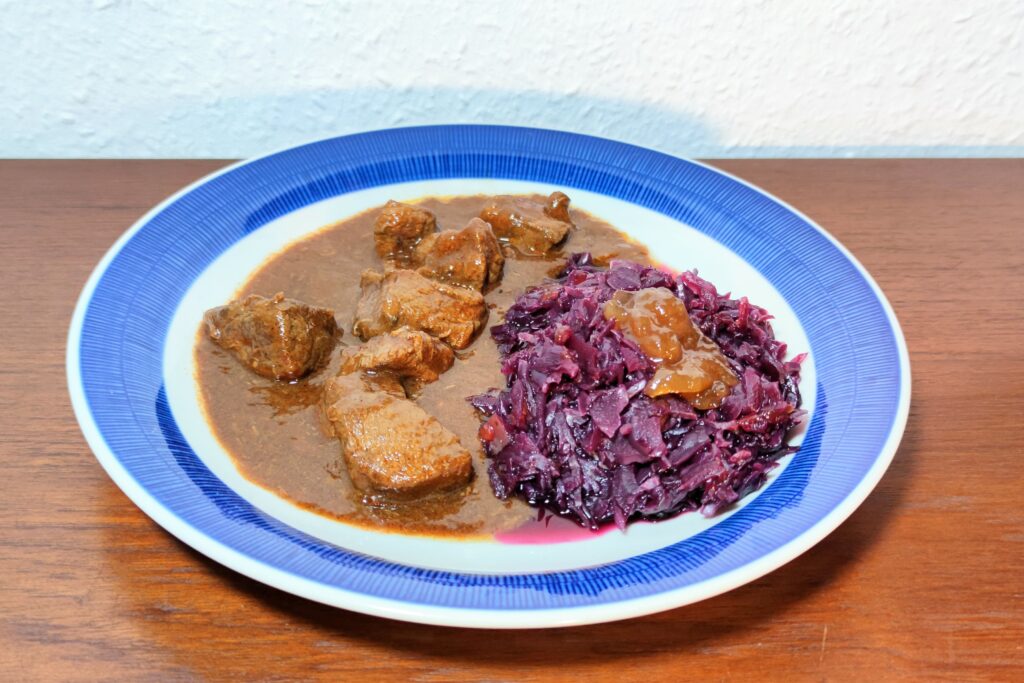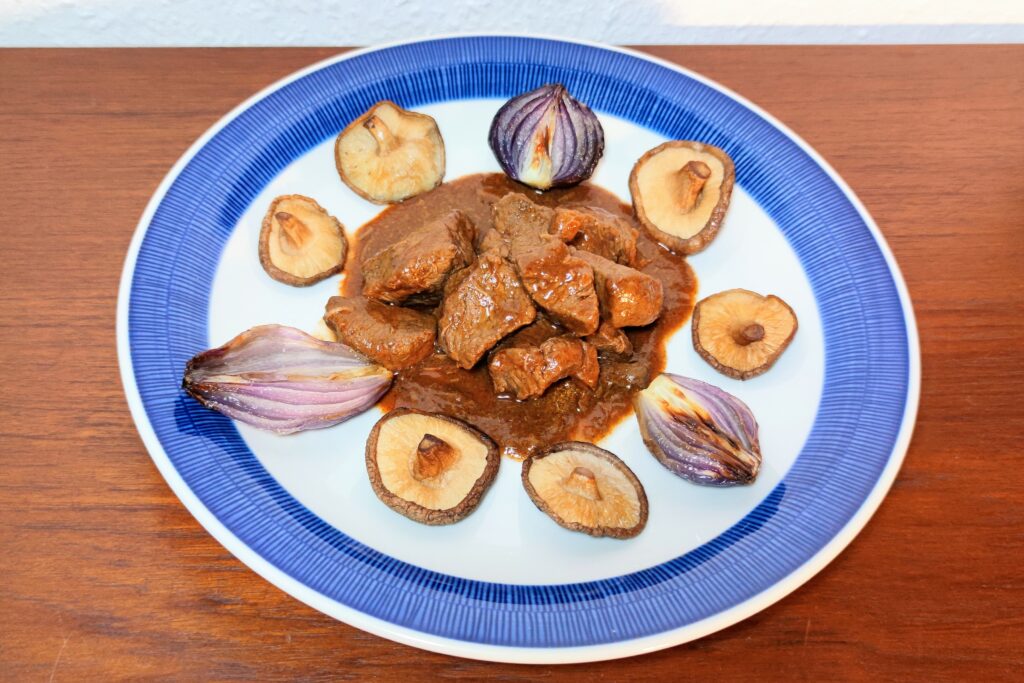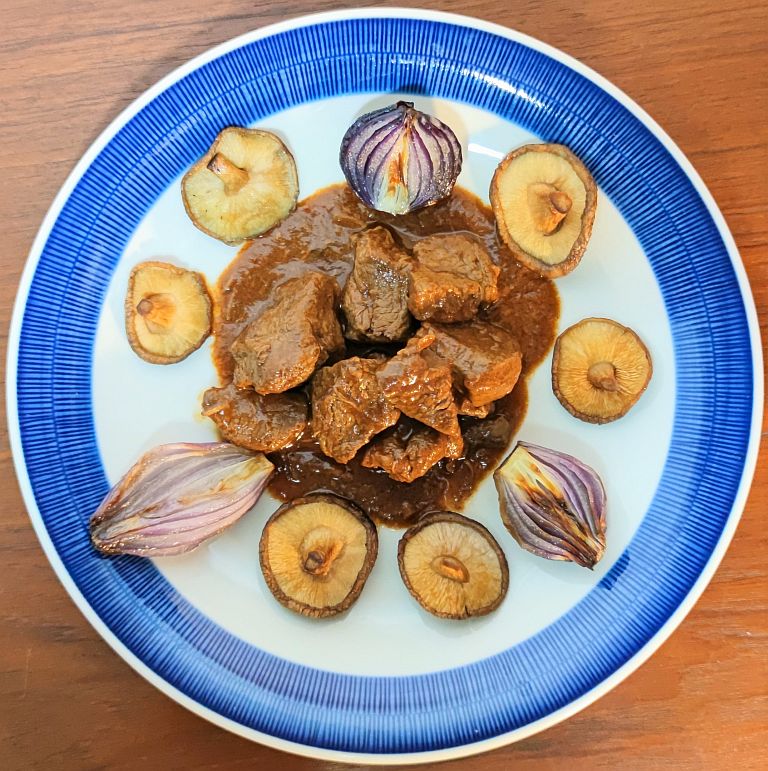It is made according to the way a ragout is made in classic French cuisine. That is, first the meat is fried and browned, and just after that the onions and garlic are added.
That is the main step which separates a ragout from a goulash. Unlike a typical stew of Anglo-Saxon origin, there are not a variety of other vegetables added to the sauce. Everything is kept as pure as possible in order to emphasize the main component, the first-class game meat.
Although this is a very simple recipe, it offers an increased complexity of flavours due to the repeated roasting process that produces a variety of savoury flavors and due to the characteristic of venison to have a more pronounced and earthy flavor than beef.
The most important thing is the multi-stage slow roasting of the meat, the repeated deglazing with liquid, which in turn boils down until it turns brown and thus switches from a cooking to a frying process. This cascade of aromatic reactions, also known as the Maillard reaction, provides the variety and richness of the savoury flavours in roasted and braised foods.
Venison really is a favourite of mine when it comes to meat dishes. From a culinary point of view, you can do everything with it that you can do with red meat, just a little bit better and tastier.
The use of potato starch (or arrowroot starch) instead of wheat flour makes it gluten free and paleo.
It is naturally low carb, the few grams of potato starch have no meaning in the overall picture.
But in order to really make it a low-carb dish, the choice of side dishes is crucial. Opt for low-starch vegetables like mushrooms, different types of cabbage like red cabbage or kale. If you want a little more carbs, starchy vegetables can also find their place at the side of the dish. Be it tubers and roots such as sweet potatoes, potatoes, Jerusalem artichokes or parsnips.

How long does this stew take to make?
It doesn’t take much time to prepare the ingredients before cooking. A few minutes to chop the onions and trim the meat if you haven’t bought ready-made diced meat.
But the searing process requires your full attention for about half an hour. You have to be extremely careful to achieve the darkest possible color and strongest possible roasted aromas without the frying process tipping over and the components burning. During this time, the ragout must be constantly monitored, stirred continuously, and liquid added in small portions in a controlled manner.
During the cooking time that follows, however, in plenty of liquid, the ragout no longer needs much attention. The cooking time is usually one to one and a half hours.
I know what they say about the cooking time of a ragout – the longer the better. But from my personal opinion, I can just say – don’t overcook it! As long as you are not working with sous vide or are using a slow cooker or crock pot. The temperature of a normal stovetop oven is normally too high so that the meat becomes dry, tough and fibrous if the cooking time is too long.
The length of the cooking time varies from person to person and depends on the size of the pieces, the temperature of the oven and the texture of the meat. While beef meat that is rich in connective tissue, such as the shoulder, is used to prepare stews such as ragout, the meat of deer, which is kept in outdoor enclosures and is usually offered for sale, does not contain as much connective tissue.
With a beef ragout, it can easily take 4 hours for the meat to become tender and tender. This is not a disadvantage, because the more connective tissue the meat has, the longer the cooking time, the more tender and aromatic the end result will be. In the case of game meat, of course, it depends very much on the age of the animal. But as long as you haven’t shot an old buck, but bought the game meat in a shop, you can assume that the meat is more tender and can be processed faster than beef.

Best ways to enjoy the Venison ragout – what to eat as an accompaniment
Not only the game ragout itself is a culinary highlight. The side dishes that are typically served with game are also among the most exciting, varied and delicious of all. They make the dish even more delicious. They often harmonize particularly well with game, as they are also wild plants from the forest. On the one hand, there are all kinds of mushrooms such as chanterelles or porcini mushrooms, or berries such as cranberries, lingonberries or blueberries, which can also be collected in the wild.
Starchy side dishes such as fresh pasta, spaetzle, mashed potatoes or potato croquettes are also popular classics. There are also winter vegetables from the cabbage family: Brussels sprouts in all variations, of course, but also hearty, fruity red cabbage. The pumpkin, omnipresent in autumn and winter, should not be missing. A particular specialty are roasted or stewed chestnuts, which with their nutty, sweet aroma also go fantastic with game.
It’s the combinations of wild, aromatic meat flavors, sweet juicy fruits and the earthier, more robust flavors of cabbages and root vegetables that make this dish so perfect.
We ate this dish for two days. Once I sautéed red onions, fried shiitake mushrooms and served it with diced, roasted potatoes. I peeled the red onions and cut them in half so that the individual onion layers were still hanging together at the root. I browned the onion halves with the cut side up in a pot with hot clarified butter and then poured some liquid on them and simmered the onions in the closed pot leave until they are done but still have a bite. I cleaned the shiitake mushrooms, cut out the stalks and fried the mushrooms whole in the Airfryer. The potatoes were peeled, cut into cubes with an edge length of 1 cm and also prepared raw in the airfryer without pre-cooking them. Instead of an airfryer, you can also simply use the convection function of the oven.
On the second day, I served red cabbage with the venison ragout, which was prepared in the classic way: with onions, apples and red wine as well as lots of Christmas spices such as cinnamon, nutmeg, cloves and allspice, slowly cooked for a few hours.
To serve, I glazed the red cabbage with my homemade apple jam, which was also made with cinnamon and coconut blossom sugar. The apples used were Elstar apples from my garden.
A classic, even downright vintage garnish that are served to accompany game dishes, that is nonetheless just fantastically appropriate are the stewed pear halves stuffed with currant jelly or cranberries as they are known from “Rehrücken Baden-Baden”.
Ingredients – here’s what you need to make the venison stew
- Venison – For this dish, it is best to use red deer leg meat. Venison is generally lean and tender. It should be free of tendons, bones and cartilage. If you have frozen meat, let it thaw first.
- Onions and garlic – they add some sweet and pungent flavor notes brought on by the mustard oils they contain. I prefer to use red onions because they also contain antioxidants due to the red color compounds. You can also use white onions or shallots. Don’t use too much garlic, it should not be too present in this dish.
- Laurel leaf, piment seeds and juniper berries – a classic seasoning for all stews and roasts. Juniper goes particularly well with game dishes and has been used since ancient times – if not since the Stone Age. Be careful when dosing the juniper berries. Too much juniper berries quickly causes a penetrating, unpleasant taste that is difficult to eliminate. If you want, you can also add peppercorns. I would recommend adding ground pepper towards the end of the cooking time when tasting. The spices are best added whole. During the cooking process that follows, they give off their aromatic substances to the stock and round off and intensify the hearty umami character
- Red wine – a fruity and sweet red wine is particularly nice, even a dessert wine like port wine goes well with it
- Tomato paste – Don’t worry, there won’t be a strong tomato aroma in the finished dish. Thorough sweating evaporates the volatile fruit acids and aromatic compounds from the tomato paste, forming brown roasted substances and roasted aromas, which later contribute to the aroma of the brown sauce. Therefore, the tomato paste must also be fried well until the color has changed from red to brown and the liquid has completely evaporated.

Substitutions and variations:
- Venison – if game meat is not available for you at the moment, you can prepare the dish with beef or lamb just as well. It is best to use a piece of beef that is suitable for stewing and not parts such as roast beef or fillet that are primarily suitable for pan frying. The cooking steps don’t change when using a different type of meat, but the time it takes for the meat to cook in the broth may well need to be adjusted. Beef usually takes a much longer time to become soft and tender. Here you have to reckon with at least 2-3 hours of pure cooking time. Red deer meat is the game meat that is best available in this country, even in the supermarket. This is because it is extensively farmed in New Zealand and exported around the world. You can just as well use roebuck or wild boar for the preparation. Of course, it is perfect if you have a hunter amongst your acquaintances who can supply you with meat from their own hunt.
- Potato starch – the use of potato starch makes the sauce light in taste, shiny and transparent. When using cornstarch, the sauce becomes significantly more opaque, slightly whitish and lumpy. Alternatively, you can use flour. It is best to sprinkle this over the components in the pan while they are frying, so that it is also roasted and has enough time to develop its binding powers during cooking. Of course, if you’re not on a gluten-free diet, you can use regular wheat flour, or any store-bought gluten-free flour alternative will work just as well
- Onions and garlic – there is really hardly an alternative to that. The onion pieces will break down during cooking anyway, giving the liquid a creamy consistency. If you don’t have onions and garlic on hand, you can just leave them out.
- Wine – Although the alcohol will evaporate from the wine and the sour, astringent wine aroma will transform during the roasting process, a distinctive flavor will remain in the finished dish when you use wine. As such, I sometimes find it better to use the more neutral option, which is broth, to prevent the rich and full flavor of the venison from being drowned out by the wine flavors. You can use any kind of broth you have on hand. Of course, it becomes really classic if you also use game stock, but if this is not available, you can also use the alternatives beef stock or vegetable stock, which have a more neutral taste. You can even use plain water, the ragout doesn’t get any worse! You might just have to adjust the amount of salt and pepper when you season the dish if necessary.
- Seasoning – You are free to experiment here and give the ragout a little more spiciness with cayenne pepper or chilli flakes. Smoked paprika powder (Piementos de Padron) also works wonderfully to give the aroma more depth. By adding more herbs, you can create a different accent. Thyme and rosemary are excellent with game meat, but have you ever tried parsley, basil or tarragon? Even mugwort goes wonderfully with game with its resinous notes.

How to store:
This venison ragout can be easily made in advance an can be stored up to 5 days in an airtight container in the fridge.
In fact, it’s a good idea to reserve an extra large portion and use it for multiple meals. The storage time gives the individual aroma compounds time to infuse well and become more harmonious
Really, has it never happened to you that you genuinely enjoy eating a stew or casserole even more on the next day?
The flavours tend to incorporate and infuse overnight. Sometimes making the perfect ragout is just a question of time!
If you can’t eat the ragout right away, you can also freeze it.

Venison ragout
Description
This venison ragout gets its deep, nuanced aroma from careful searing and slow stewing of the flavour red deer meat. It is a highlight on every dining table on special occasions and will impress your family and guests alike.
Ingredients
Instructions
-
Trim any tendons or fatty tissue from the meat. Dice into 4 cm cubes.
-
Heat the clarified butter in a heavy roaster. Add in the meat cubes and sear on all sides so that they are well browned. If excess liquid leakes from the meat it has to evaporate first before the roasting process can continue.
-
When the liquid from the meat cubes has evaporated and the meat has gotten enough color on all sides, add the diced onion and finely diced garlic. If there is not enough fat in the pan, these components will burn easily, so you may need to balance the amount of fat and melt some more clarified butter in the pan before adding the onions and garlic. Continue frying until the onions are translucent and starting to brown.
-
When the cubes are well browned and a brown deposit has formed on the bottom of the roasting pan, it's time to deglaze the dish with some liquid. You can use red wine or another liquid like broth or plain water to deglaze.
-
Add the liquid to the roaster. While it is simmering, use a spatula to scrape the toppings off the bottom of the casserole well. These are the toasted ingredients that will later form the basis of the sauce.
-
The liquid now boils down again, becomes more viscous and the more water evaporates, the more aroma-forming reactions take place in the liquid. When the liquid has evaporated and the cooking process returns to frying, add the tomato paste and sauté well, stirring constantly.
-
Just when the contents of the pan are on the verge of browning and burning too much, pour in more of the liquid and cook off the sediment again, stirring and scraping with the spatula.
-
Repeat the process three to four times. Honestly, as often as possible is better. The quality of the sauce is directly dependent on how intensively the process of searing and boiling down was carried out, i.e. how intensively the Maillard reaction took place. Repeat the deglazing and simmering process three to four times until you have enough base for the sauce.
-
Pour enough broth over the meat cubes to almost cover them. Add salt and the spices. For this amount of the dish, one bay leaf, two grains of allspice and two juniper berries are enough.
-
Remove any deposits on the bottom of the pot before cooking by gently scraping and clean the walls of the pot from the inside so that no caking forms there. Close the pot with a lid and let the ragout simmer over low heat on the stovetop. Alternatively, you can also place the pot in the oven at 150°C bottom and top heat. There the meat is cooked even more gently and the individual pieces are less likely to fall apart.
-
The cooking time is about an hour. Test the doneness by piercing a piece of meat with a meat fork. It should slide easily off the tines of the meat fork on its own. If the cooking time is not right, increase the cooking time a little and try again in 15 minutes. Then test the doneness again.
-
When the meat has reached its perfect doneness, remove the bay leaf and the allspice and juniper berries. If you have cooked the ragout in the oven, place the roaster back on the hot stovetop. To bind the liquid and adjust the consistency of the sauce, it should be beneficial to use some starch to bind. Mix the starch with some cold water. Bring the ragout to the boiling point and pour the starch suspension into the simmering liquid while stirring. Stir well and let simmer for a few moments until you can feel the consistency changing and becoming thicker.
-
Now season the sauce with salt, pepper, ground allspice and nutmeg. It is also very tasty to add ground dried thyme, rosemary, lovage and oregano.
-
Serve with the side dishes of your choice.








